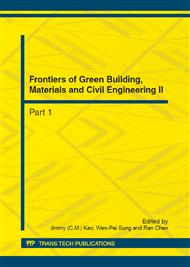p.1346
p.1352
p.1357
p.1361
p.1365
p.1371
p.1376
p.1380
p.1384
Experimental Research of Bending Capacity of Normal Section of Steel Fiber Reinforced Concrete Wall-Beams Simply Supported
Abstract:
Because the joists in the wall-beams are in eccentric tension during work and the concrete tensile strength is low, the bending capacity of normal section of wall-beams is not too large. Steel fibers mixed into the concrete, playing enhancement and crack-resistance roles would lead to changes in the nature of concrete materials so that it is impossible to fully use the existing research results of ordinary concrete wall-beams simply supported when studying bending behavior of normal section of steel fiber reinforced concrete wall-beams simply supported. Therefore, it is necessary to do pilot studies on bending behavior of normal section of steel fiber reinforced concrete wall-beams simply supported. Based on the vertical static load test of 12 steel fiber reinforced concrete wall-beams simply supported specimens under different fiber volume ratio conditions, the strains of steel and concrete, cracking load, failure load and development situation in the cracks were tested while working characteristics of steel fiber reinforced concrete wall-beams simply supported were studied. This paper discussed the effect of fiber volume ratio on cracking moment and ultimate moment of steel fiber reinforced concrete wall-beams simply supported, which shows that the optimum mixing amount of steel fiber is 1.2%. The conclusion is of great significance in both theory and engineering practice, and it helps to guide the application of practical engineering.
Info:
Periodical:
Pages:
1365-1370
Citation:
Online since:
August 2012
Authors:
Price:
Сopyright:
© 2012 Trans Tech Publications Ltd. All Rights Reserved
Share:
Citation:


